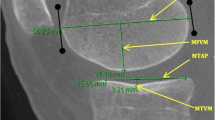Abstract
Objective
Meniscal tears are an important cause of morbidity. The aim of this study was to examine the relationship between non-traumatic meniscal tears and the intrinsic bony morphology of the knee.
Methods
A retrospective analysis of 160 knee MRI scans in 150 patients was carried out who met the following criteria: (a) age between 20 and 45 years, (b) no history of knee trauma, surgery, infection, metabolic bone disease, and (c) no collateral or cruciate ligamentous injury. The medial tibial slope (MTS), lateral tibial slope (LTS), medial tibial plateau depth (MTPD), and medial and lateral femoral condylar offset ratios were calculated. The anterior horn, body, and posterior horn of the menisci were graded as 0 (no tear), 1 and 2 (degenerative changes), or 3 (definitive tear). One-way ANOVA and linear regression was used for statistical analysis.
Results
In patients with grade 3 tears of the posterior horn of the medial meniscus, there was a significant association with shallower MTS (p < 0.05), smaller medial femoral offset ratio (p < 0.05) and smaller lateral femoral offset ratio (p < 0.05). Patients with grade 3 tears of anterior horn of the lateral meniscus had a significant association with shallower LTS (p < 0.05). No significant association was seen between MTPD and meniscal tears.
Conclusions
Our results suggest an association between bony morphology of the knee and non-traumatic meniscal tears. Shallower MTS and LTS may result in impingement of posterior horn of medial meniscus and anterior horn of lateral meniscus, respectively. Future kinematic studies will be needed to help confirm our findings.










Similar content being viewed by others
References
Rytter S, Jensen LK, Bonde JP, Jurik AG, Egund N. Occupational kneeling and meniscal tears: a magnetic resonance imaging study in floor layers. J Rheumatol. 2009;36:1512–9.
Englund M, Guermazi A, Gale D, et al. Incidental meniscal findings on knee MRI in middle-aged and elderly persons. N Engl J Med. 2008;359:1108–15.
Bhattacharyya T, Gale D, Dewire P, et al. The clinical importance of meniscal tears demonstrated by magnetic resonance imaging in osteoarthritis of the knee. J Bone Joint Surg Am. 2003;85-A:4–9.
Baker P, Reading I, Cooper C, Coggon D. Knee disorders in the general population and their relation to occupation. Occup Environ Med. 2003;60:794–7.
Church S, Keating JF. Reconstruction of the anterior cruciate ligament: timing of surgery and the incidence of meniscal tears and degenerative change. J Bone Joint Surg (Br). 2005;87:1639–42.
McGuire DA, Barber FA, Hendricks SD. Meniscal impingement syndrome. Arthroscopy. 1996;12(6):675–9.
Hudek R, Schmutz S, Regenfelder F, Fuchs B, Koch PP. Novel measurement technique of the tibial slope on conventional MRI. Clin Orthop Relat Res. 2009;467(8):2066–72.
Johal P, Hassaballa MA, Eldridge JD, Porteous AJ. The posterior condylar offset ratio. Knee. 2012;19(6):843–5.
Cinotti G, Sessa P, Ripani FR, et al. Correlation between posterior offset of femoral condyles and sagittal slope of the tibial plateau. J Anat. 2012;221(5):452–8.
Cooper DE, Arnoczky SP, Warren RF. Meniscal repair. Clin Sports Med. 1991;10(3):529–48.
Baker P, Coggon D, Reading I, et al. Sports injury, occupational physical activity, joint laxity, and meniscal damage. J Rheumatol. 2002;29:557–63.
Snoeker BA, Bakker EW, Kegel CA, Lucas C. Risk factors for meniscal tears: a systematic review including meta-analysis. J Orthop Sports Phys Ther. 2013;43(6):352–67.
Metcalf MH, Barrett GR. Prospective evaluation of 1485 meniscal tear patterns in patients with stable knees. Am J Sports Med. 2004;32(3):675–80.
Terzidis IP, Christodoulou A, Ploumis A, et al. Meniscal tear characteristics in young athletes with a stable knee: arthroscopic evaluation. Am J Sports Med. 2006;34(7):1170–5.
Messner K, Gao J. The menisci of the knee joint. Anatomical and functional characteristics, and a rationale for clinical treatment. J Anat. 1998;193:161–78.
Masouros SD, McDermott ID, Amis AA, Bull AM. Biomechanics of the meniscus-meniscal ligament construct of the knee. Knee Surg Sports Traumatol Arthrosc. 2008;16(12):1121–32.
Giffin JR, Vogrin TM, Zantop T, et al. Effects of increasing tibial slope on the biomechanics of the knee. Am J Sports Med. 2004;32(2):376–82.
Freeman MA, Pinskerova V. The movement of the normal tibio-femoral joint. J Biomech. 2005;38(2):197–208.
Hashemi J, Chandrashekar N, Mansouri H, et al. Shallow medial tibial plateau and steep medial and lateral tibial slopes: new risk factors for anterior cruciate ligament injuries. Am J Sports Med. 2010;38(1):54–62.
Conflict of interest
The authors declare that they have no conflicts of interest.
Author information
Authors and Affiliations
Corresponding author
Rights and permissions
About this article
Cite this article
Khan, N., McMahon, P. & Obaid, H. Bony morphology of the knee and non-traumatic meniscal tears: Is there a role for meniscal impingement?. Skeletal Radiol 43, 955–962 (2014). https://doi.org/10.1007/s00256-014-1867-9
Received:
Revised:
Accepted:
Published:
Issue Date:
DOI: https://doi.org/10.1007/s00256-014-1867-9




